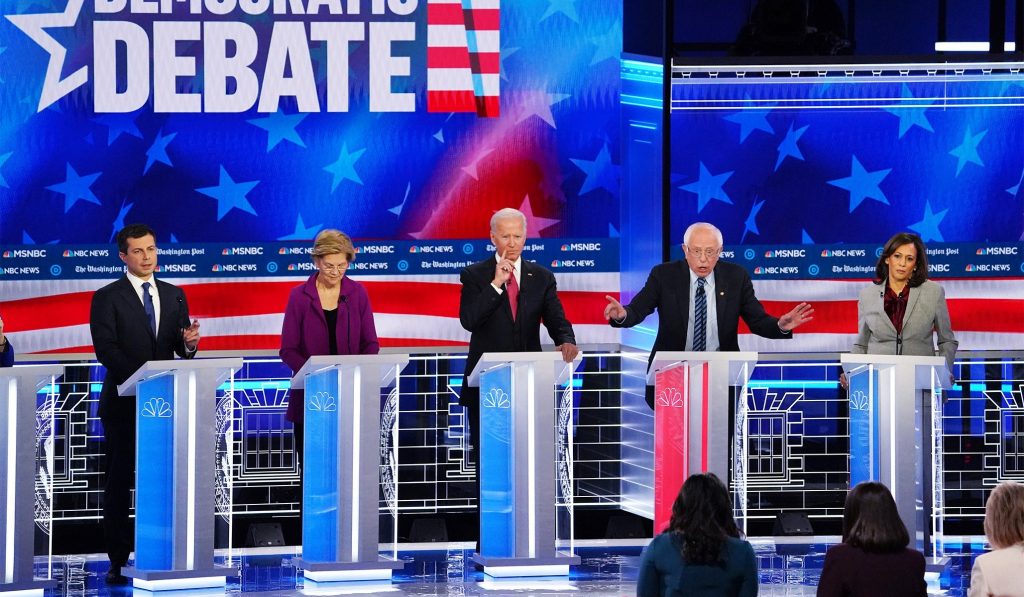Amelie Lee ’23
Copy Editor
March 5, 2020
Iowa. New Hampshire. South Carolina. What do these states have in common—other than being America’s first look at who might be the nominee for the most important job in the country? Well for one, they’re all on the bottom half of a list collected by FiveThirtyEight ordering states in the order that best represents the ethnic demographic of the Democratic party.
Most people are relatively aware about the drawbacks of the electoral college. In fact, a couple of the Democratic presidential candidates are running on a platform that includes abolishing the electoral system altogether. Yet, another aspect of the election process, nearly just as influential, often lacks the same sort of widespread critique and attention: America’s primary system. Vox Media recently released a video titled “America’s presidential primaries, explained,” drawing insight on why our system works the way it does—and some of the criticisms it’s faced.
After doing a bit of research and learning about the history of our primary system, I came to a conclusion: nothing about it makes any sense. When adopting the system during the Vietnam War, the Democratic Party was trying to accomplish two things. Firstly, they wanted to allow voters to choose the nominee, instead of the delegates of the party directly voting for their preferred candidate. Secondly, they wanted to slowly strain out a large batch of candidates, petering them out by a series of caucuses and primaries before the DNC, preventing candidates with the most name recognition or funding from winning before giving underdogs a chance. While this all sounded reasonable, the actual choices of which states would go first was based purely on the technological limitations of the time, with Iowa claiming it took them a long time to collect votes. There was no strategy involved in arranging the rest of the states, with New Hampshire and Nevada eventually fitted in the next two most influential primary dates.
Equally as confusing is the lack of nation-wide ranked choice voting. While only four states currently use ranked choice voting in the presidential primaries, few recent candidates have brought it up, with only former candidate Andrew Yang making it a key point of his campaign. The most obvious benefit of ranked choice voting is creating a more nuanced perspective of voter opinion, allowing less partisan infighting, as well as higher statistics of voter turnout. When it comes to election years like this one, the influx of candidates dropping out is also a strong argument for ranked-choice voting; it seems absurd that Pete Buttigieg’s delegates are not legally bound to vote for any candidate—a problem that could be fixed with a more involved ballot.
While most news sources release an editorial or two about this subject every election season, the lack of attention to these integral aspects of our presidential election seems ridiculous. When it comes to the peculiar system of caucuses and primaries, Iowa has a 90% caucasian population, while New Hampshire somehow surpasses this with a 93% caucasion population (World Population Review). Even within the Democratic party in Iowa, 86% of its members identify as white (Pew Forum). This blinding white stands in stark contrast to America as a whole (40% of people of color) and the Democratic party (60% people of color). It’s absurd that these states—that hold their primary weeks before any other— have such an influential role in the presidential nominee. For years, people have looked to the Iowa Caucus as a representation of American voters and values— after all, since 1976, seven out of nine Iowa winners have gone on to take the Democratic nomination later that year. Presidential candidates spend an absurd number of weeks campaigning in those specific areas, ignoring the swaths of territory whose voices don’t get heard until Super Tuesday.
So what’s the solution? It’s time to figure out a primary system that actually makes sense given modern voter demographics. In 2016, NPR compiled a list of states that best represent America as a whole, in terms of ethnicity, education, age, income, and religion. Not only that, but multiple news sites have done this, including FiveThirtyEight’s 2019 list that bears similar results. Both lists tell us that Illinois would be a far more accurate portrait of what American voters believe, and Iowa and New Hampshire are not an accurate racial fit by any means.
In a rare case of American politics, the solution has been given to us— in a neatly compiled list by credible news sources— we’re just lacking discussion and motivation to enforce it. While presidential candidates are busy campaigning and manipulating the primary system we’ve been handed, they need to look at whether the game they’re playing is one with rules that make sense.
Image Credit: National Review



